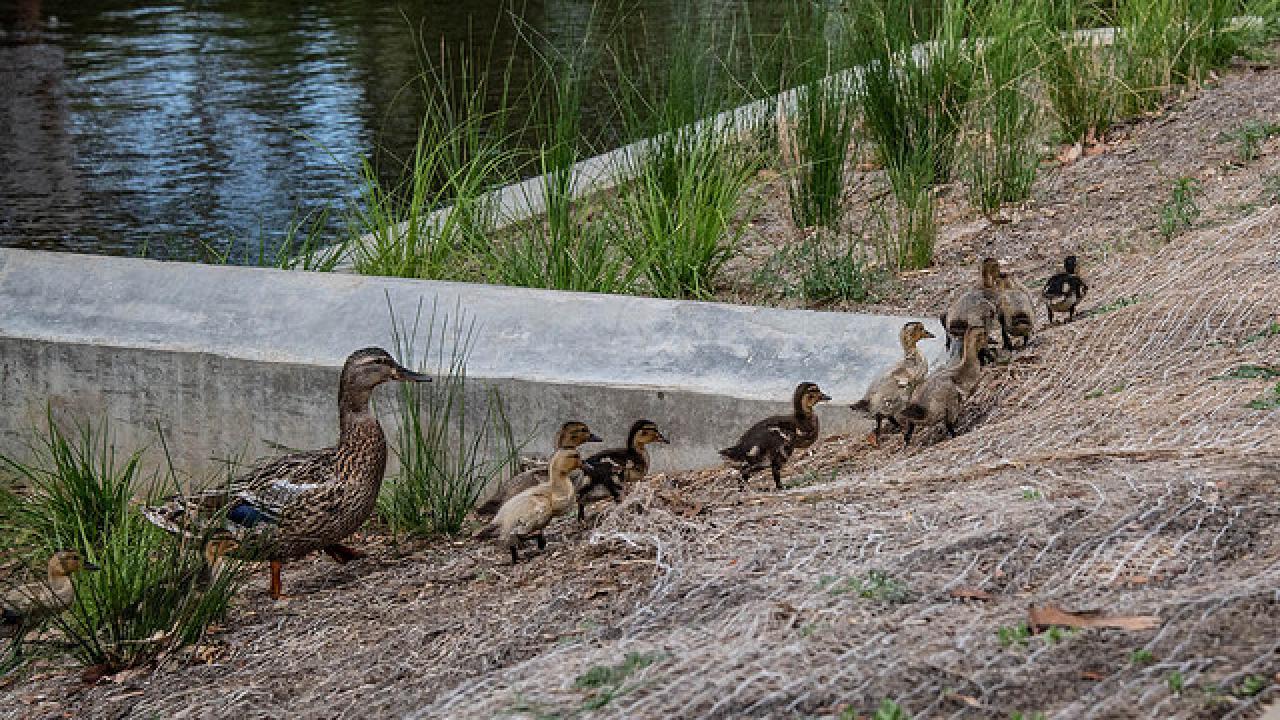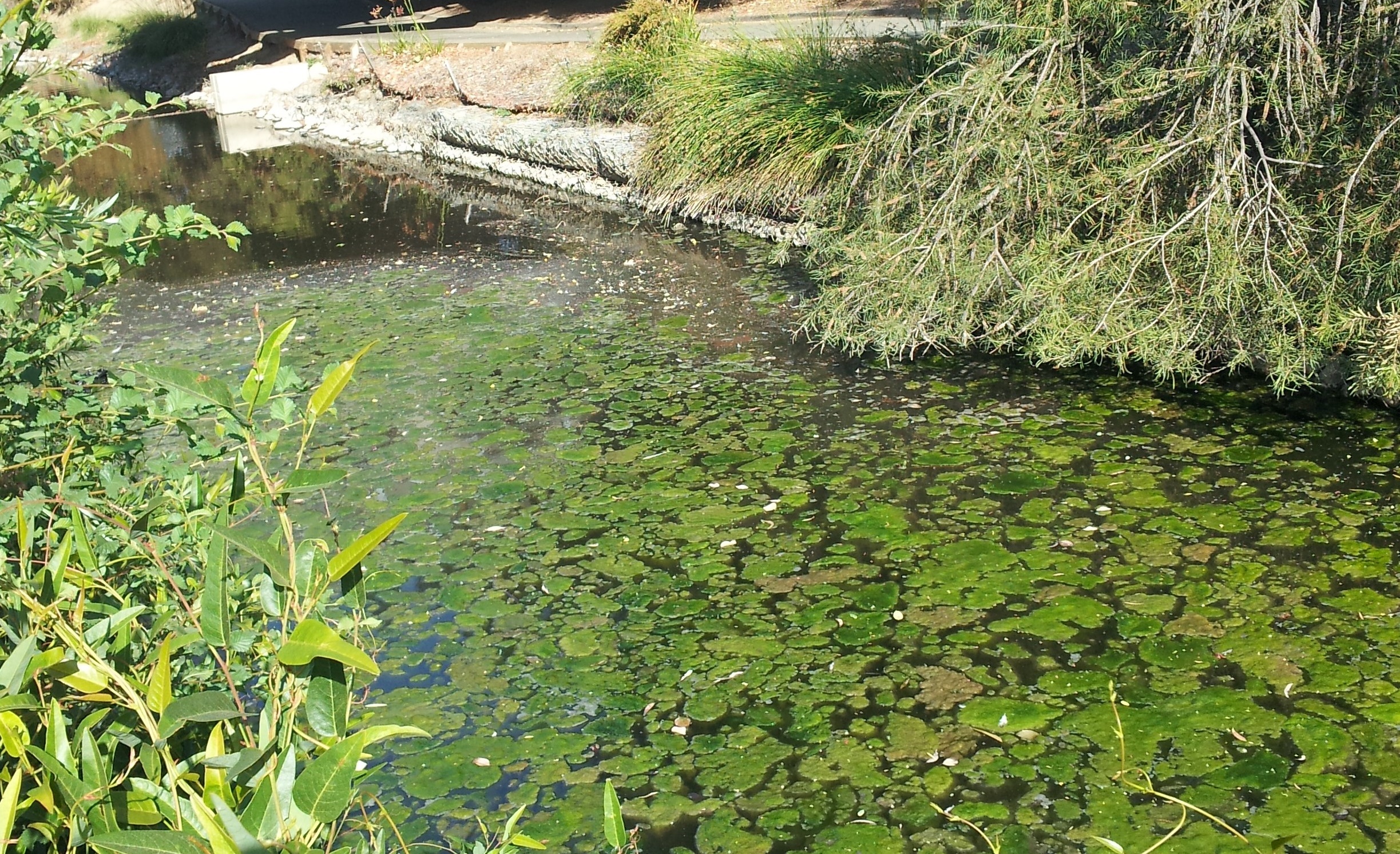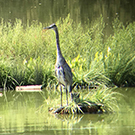
Arboretum Waterway wildlife post Phase One construction
by Nina Suzuki, waterway steward and Andrew Fulks, assistant director
Now that phase one of the Arboretum Waterway Maintenance and Enhancement Project is complete, we are enjoying watching the wildlife explore some of the new features of the waterway. The project achieved multiple goals; it addressed recurring issues like sediment build up, engineered in features to reduce surface algae and duckweed overgrowth and enhanced the Arboretum Waterway’s primary role as the outlet for all our campus stormwater and recycled water. In addition, all of these improvements offer the added benefit of improving the waterway's function as a wildlife habitat including increasing dissolved oxygen in the water for fish, creating basking sites for turtles and adding vegetation at the water’s edge to filter water and provide food and habitat. So far, we have seen a tremendous positive response.

Remember those rock and wire gabions that used to line the banks? Before the project was completed, turtles were unable to bask on the banks of Phase 1 because the gabions blocked them. We know that basking is critical for the turtles’ thermoregulation. The vertical rock gabions made it impossible for them to bask in safe locations right next to the water, so the turtles in this stretch were relegated to basking on exposed storm water pipes. Now we see them basking all over the banks, right at the edge of the water, among our new plantings of California native rushes and sedges.
Fish were almost non-existent in this end of the waterway, due to low dissolved oxygen levels. On the east end, pre-project oxygen levels dropped to almost zero, whereas in other parts of the waterway measurements showed up to 8 mg/L of dissolved oxygen. Warm water fish, like those we have in the waterway generally need at least 4 mg/L. Now that the project is finished, we are seeing all of the species of fish that we know are in the waterway, in the east end project area. They came back in on their own, swimming up from the other parts of the waterway. We even saw some carp who seem to be spawning!
After the completion of the project, the area is much more suitable for wildlife. Egrets stalk fish from the shoreline and the weirs. Schools of fish gather where the water flows over the weirs, which simulate riffles found on natural creeks. Catfish ball together to appear bigger and ward off larger predator fish like carp, which cruise the waterway looking for their next meal. And the turtles line up on the now-accessible banks, basking in the sun.
Now that we have this new system of weirs and pumps in place, we are learning how to best use these tools to improve water quality while maintaining stormwater conveyance. For example, we're learning how soon before a storm we need to shut off the pumps and let natural storm water flow make up the bulk of the flow over the weirs. We are learning when to open the screw gates to lower water levels prior to storm events, and we are learning when and how to operate the pumps to meet the aesthetic objectives as well as keep the wildlife healthy.
In the past, localized fish kills have occurred in the waterway. After exploring the possible causes, the mortality appeared to be related to low dissolved oxygen in the water. Levels can change naturally due to changes in season (temperature affects how much oxygen water can hold), or an influx of water from a storm. In addition, higher biological activity in the water can use up oxygen faster. Now that we have the pump and weirs installed in the east end of the waterway, we have the ability to pump the higher oxygen water from Lake Spafford, to the east end, where the dissolved oxygen was nearly zero prior to Phase 1 construction. We will continue to learn and adjust the water flow in order to maintain this healthier waterway for fish and other wildlife.
Changes along the waterway as a result of the project lead to a number of questions from the public. Here are the answers to questions we have received since completing Phase 1.
Q. Do the weirs prevent the ducks and turtles from moving up and down the waterway?
A. No, the ducks and turtles have re-inhabited the Phase 1 waterway area in abundance. While the turtles can’t climb directly over the weirs and waterfalls, they do walk around them. The ducks lift themselves over the weir’s water drops with ease, and baby ducks follow their mothers around each weir when they are too young to hop over the drops.
Q. Do the weirs block the fish from moving upstream and downstream?
A. No, the weirs are a minor impediment to fish movement, and mimic water drops and obstacles that would be found in natural waterways. Fish still move between weirs by swimming upstream during storm flows, when the water depth over the weirs is greater. They move between weirs in the winter, before, during, and after storms, when the underwater screw gates are open. Lastly, they move between weirs by jumping over the minor fall at each weir. Often you will find fish schooling below a weir, enjoying the higher-oxygen water flowing between their gills. On occasion, you might be lucky enough to see one jump over the weir, continuing the journey upstream.
Q. I like the more natural look of the Waterway. Are the concrete walls next to the weirs going to be so visible in the future?
A. Most of the concrete walls will soon be underwater. Once the plants adjacent to the weirs grow tall enough, we will raise the water level so that the walls are covered by an inch or two of water and the wetland plants will cover up most of the concrete walls. In the end, you will only see the part of the weir perpendicular to the water flow.

Wildlife take advantage of floating island
Blue heron, Canadian geese, Western pond turtles and more are all using the new floating island located in the west end of the Arboretum Waterway.
